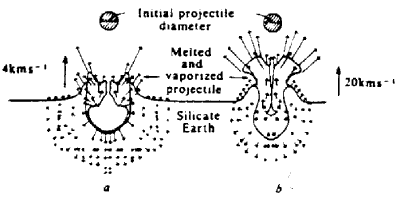 |
Science Frontiers ONLINE No. 23: Sep-Oct 1982 |
|
|
The cretaceous-tertiary extinction bolide
The recently discovered worldwide iridium-rich layer is taken by many scientists as evidence of the collision of an asteroid or comet with the earth about 65 million years ago. This cataclysmic event is also blamed (by some, at least) for the apparent sudden biological extinctions recorded on these pages of the fossil record. In this setting, the authors of this paper calculate the effects on the earth of a 10-kilometer-diameter object impacting at about 20/km/sec.
Do the theoretical results jibe with the geological and paleontological data? Very definitely. Crater ejecta rich in extraterrestrial material would be blasted to an altitude of 10 km, where winds would insure global distribution. In terms of biological stress, the 10-km projectile would transfer 40-50% of its kinetic energy to the atmosphere, creating a heat pulse that could raise global temperatures 30�C (50�F) for several days. Many large animals might well succumb to such a temperature transient. In addition, the protective ozone layer might be blown away by shock waves and not reform for a decade.
(O'Keefe, John D., and Ahrens, Thomas J.; "Impact Mechanics of the Cretaceous-Tertiary Extinction Bolide," Nature, 298,123, 1982.)
Reference. We catalog biological extinctions at ESB1 in Anomalies in Geology. To order this book, visit: here.
 | Fig. 1. Particle velocity flow field from a silicate projectile impacting a strengthlessness silicate surface at 15 and 45 km s-1. Flow fields at a, t = 8.2; b, t = 3.1 where r is normalized time. |